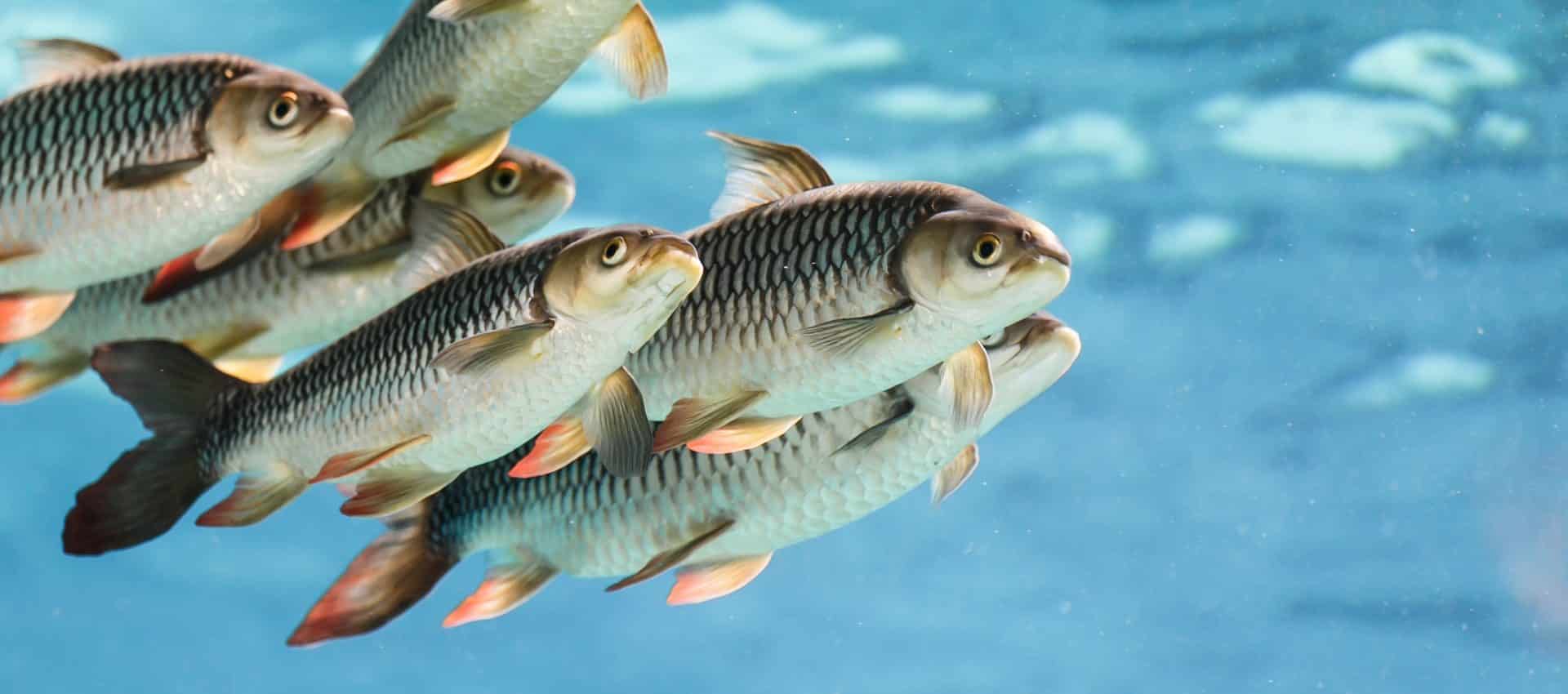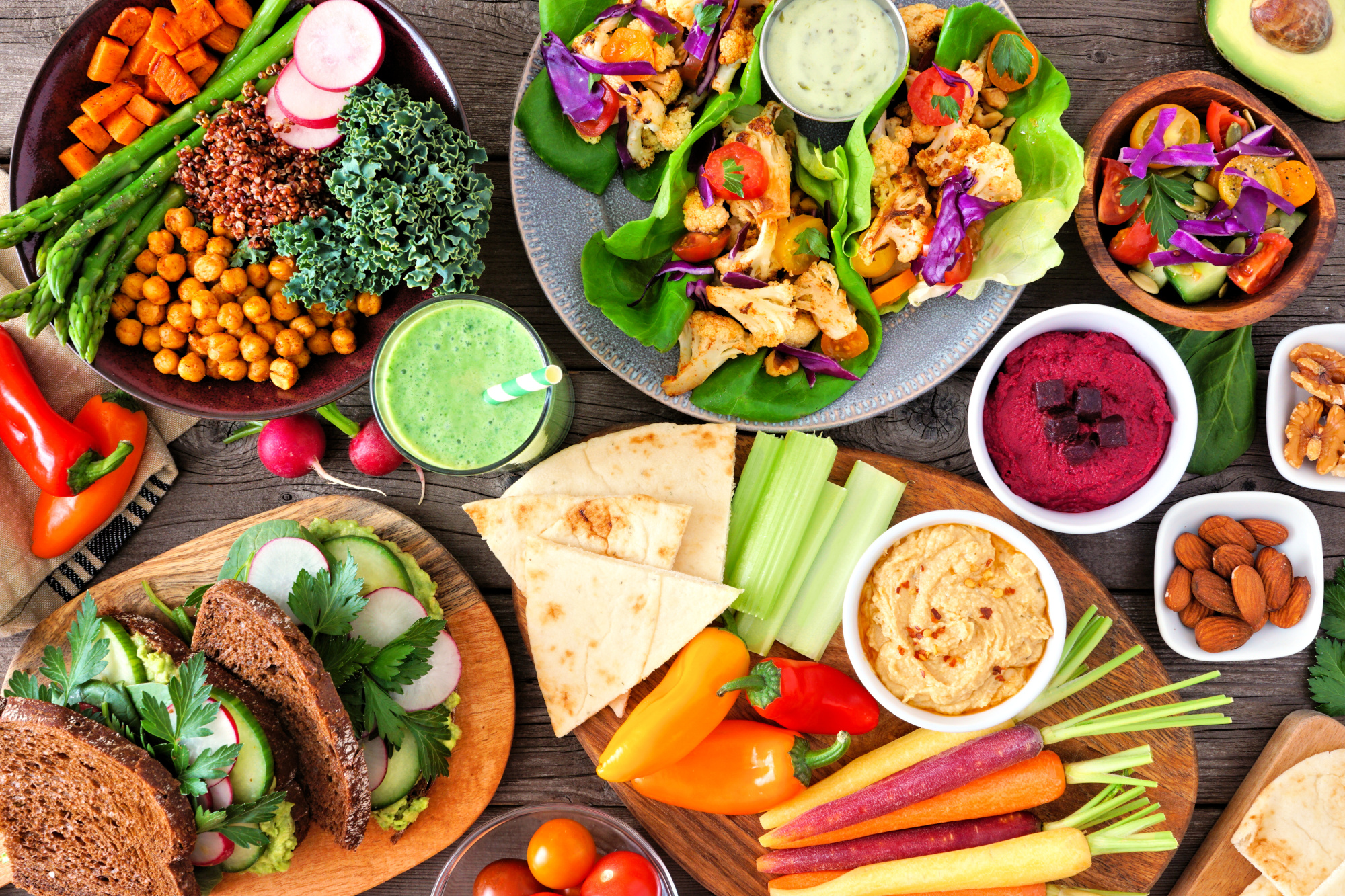Fish have the same capacity to feel pain as mammals. Yet millions of tonnes of fish are caught each year and an increasing number of species are at risk of extinction. ProVeg explains why sustainable fishing and fish farming is impossible in practice.
The consequences of overfishing
Fish are one of the oldest and most biodiverse groups of vertebrates inhabiting our planet. They populate almost all the earth’s waters, but their numbers are dwindling rapidly. It is particularly hard for us to imagine the world that fish inhabit. We rarely think of them as individuals – in most cases, we speak of them as collective beings, described in kilograms and tonnes.
Each year, around 96 million tonnes of these marine creatures are taken from the sea and subsequently die in pain and distress.1 2.3 trillions of these sentient creatures perish each year – and this does not include the numbers killed by the rampant practice of illegal fishing.2
The global demand for fish is rising. Figures released by the Food and Agricultural Organization of the United Nations (FAO) indicate that fish consumption per capita was about 20 kg in 2017.3 4 Among the main reasons for this steady increase in fish consumption are technological developments, but also rising incomes and an increasing demand for fish products, especially in the younger population.5 6
Fish stocks are rapidly dwindling due to overfishing
Fish stocks are still declining around the world. Today, over 90% of fish stocks are considered either overfished or exploited close to the point of unsustainability.7
Climate change and warming oceans are now also affecting fish stocks and the growth of many species might be negatively affected.8 A recent study showed that industrial fishing is occurring in more than 55% of ocean area – four times the area used by agriculture.9
Bycatch causes unnecessary suffering and death
Environmentally hazardous fishing methods and inadequate fishery laws wreak havoc on the oceans and their inhabitants. Each year, several million marine animals end up in fishing nets as bycatch. The term ‘bycatch’ describes sea dwellers that are not the targeted animal – including 300,000 whales and dolphins10 but also seabirds and other marine mammals that get caught in fishing nets. Most of them do not survive the ordeal – they either perish in the nets or die a slow death later on due to injury or stress.11 It is estimated that around 40% of the captured animals are bycatch12 – many are discarded while some are also used as feed in aquaculture.13
Increasing imbalance in the marine ecosystem
Overfishing wreaks havoc on marine ecosystems. As well as the populations of species intended for human consumption, the stocks of animals caught as bycatch are also declining. Rampant fishing also causes immense damage to the seabird, jellyfish, and plankton populations.14 15 16 Beyond the sheer volume of fish caught, the fishing methods used are especially damaging to ecosystems as a whole. Bottom-trawl nets, for instance, which are used to catch plaice, sole, and crustaceans, destroy the seabed and the organisms living there, including coral.
Fish farming in aquacultures
In recent years, there has been an alarming rise in the number of aquafarms around the world. As well as carp, trout, and catfish, fish farms also breed other fish such as salmon and bream and other marine dwellers, including shrimps, crabs, and even mussels. In 2018, aquafarms produced over 80 million tonnes of aquatic animals.17 Systems for aquafarming range from inland ponds to extensive cage setups in the ocean. As a result of the high density common in fish farming, the animals experience elevated levels of stress and increased susceptibility to injury and disease.18 19
Fish eats fish
Aquafarms frequently breed predators such as salmon or trout, which require smaller fish as fodder, thus exacerbating the problem of overfishing.20 21 Fishmeal and fish oil production has become a huge industry supplying aquafarms and the livestock industry with fish meal and fish oil to feed billions of animals. About 20-30% of wild caught fish are used as animal feed, with a large part of this potentially suitable for direct human consumption.22 23 It is estimated that producing one kilogram of farmed fish requires up to 2 kilogram feed.24 25 Some argue that the amount of fish used to produce 1 kilogram of salmon is now below 1kg. However, feed for fish not only contains fish meal but also large quantities of plant-proteins (soya, for example) and might also contain ingredients from livestock farming such as meat- and bone meal, and blood meal.
Impact of fish farming on the environment
Additionally, aquaculture damages the environment in numerous ways. Faeces and feed residues burden the environment and can lead to over-fertilisation of waters and a decline in biodiversity. The use of antibiotics and industrial chemicals further pollutes the waters and can, in a worst-case scenario, encourage the emergence of drug-resistant bacterial strains that may present a risk to humans as well.26 27
Fishing is a form of animal cruelty
Although many people now reject the practice of hunting wild game, fishing is still widely perceived as a relaxing hobby – perhaps because most people do not realise that fish are sentient beings who can experience pain. Hobby fishing causes substantial suffering to fish: the hook produces deep wounds in the oral cavity, while the fish slowly suffocates after being taken out of the water. ‘Catch-and-release’ fishing is a similarly traumatic experience, even though the fish is thrown back into the water. After being released, the animals suffer significant stress and injury, returning to the water with substantially depleted reserves of strength and a reduced a chance of survival.
Fish maintain different social systems
As with the vast spectrum of land animals, fish also have strongly varying social systems.28 29 For example, trout are regarded as loners, while other fish species live as couples or form loose groups or large shoals (as is the case with tuna). Fish possess long-term memory and are therefore able to establish complex social relationships. Additionally, they are equipped with spatial memory, allowing them to create mental maps that they use to navigate.30 In a recent study, a species of cleaner fish was shown to be able to remember a negative experience and showed hiding behaviour near the place they were caught.31
Fish have feelings and can experience pain
The assertion that ‘fish do not feel pain’ is frequently used to stifle any discussion of whether fish are able to suffer. But the inability to scream simply means that the pain felt by fish remains invisible and unheard. It follows, therefore, that we do not generally experience the same pangs of conscience that we feel in relation to pigs, cattle, or chicken. Nevertheless, researchers increasingly confirm that fish feel pain. Fish, like mammals, have sensory systems as well as cerebral structures and functions that are responsible for the perception of pain, fear, and stress.32 33 34 35 This is substantiated by behavioural patterns such as defensive reactions to pain stimuli.36 37
Fish contain harmful mercury, dioxin and lead
Fish absorb and accumulate the contaminants contained in seawater. There is a pertinent rule of thumb: the higher up the fish is in the food chain, the greater the toxin concentration in its body. This is troubling news for those who are accustomed to eating popular species such as salmon or tuna38 – large predators that feed on smaller marine creatures and, in doing so, absorb toxins which accumulate in their bodies and become increasingly concentrated over time (this is known as bioaccumulation).39 People with a liking for fish will therefore consume mercury, PCBs (polychlorinated biphenyls), dioxins, lead, and arsenic, all of which can lead to a variety of conditions, ranging from kidney damage to cognitive decline, some forms of cancer, and even death.40 41 Fish bred on aquafarms do not present a healthier alternative. After all, they are treated with antibiotics and chemicals to fight parasites and skin and gill infections – all consequences of the unnatural farming conditions.
A fundamental change in our collective mindset is needed
Not only are fish able to feel pain, they also possess complex cognitive skills and social structures. Additionally, fishing and fish farming have negative impacts on the environment and our health, all of which makes fish an unsustainable source of food. A fundamental change in mindset is needed in view of the exorbitant fishing quotas and the burden placed on the environment, nature, and fish populations. The availability of plant-based products similar to fish is on the rise. From plant-based fish burgers to caviar, calamari, prawns and shrimp, there is an alternative for every occasion. In this article, ProVeg presents the most popular options and explains how to use them in the kitchen.
ProVeg supports the availability of plant-based fish alternatives
ProVeg does not only point out healthy, cruelty-free alternatives, but also makes them more readily available. ProVeg supports and facilitates a range of vegan events throughout the year, from annual happenings such as VeggieWorld and VegMed to important one-off events such as CEVA trainings and legal and political symposiums. Furthermore, the ProVeg Incubator advises and supports innovative companies that want to enrich the veggie market with their products. This ranges from mentoring early-stage start-ups to consulting for major international supermarket brands and administering the V-Label, which guarantees that a product is either vegan or vegetarian. Find out more about what we are doing to help the world transition to a more plant-based society and economy that are sustainable for humans, animals, and our planet.
References
- FAO (2020): The State of World Fisheries and Aquaculture 2020. Sustainability in action. Rome.
- A. Mood and P. Brooke (2019): Numbers of fish caught from the wild each year. Available at http://fishcount.org.uk/fish-count-estimates-2/numbers-of-fish-caught-from-the-wild-each-year [09.12.2020]
- FAO (2020): The State of World Fisheries and Aquaculture 2020. Sustainability in action. Rome.
- FAO (2016): The State of World Fisheries and Aquaculture 2016: Contributing to food security and nutrition for all. Rome.
- FAO (2020): The State of World Fisheries and Aquaculture 2020. Sustainability in action. Rome.
- Supartini, A., T. Oishi & N. Yagi (2018): Changes in Fish Consumption Desire and Its Factors: A Comparison between the United Kingdom and Singapore. Foods 7(7), 97. doi:10.3390/foods7070097
- FAO (2020): The State of World Fisheries and Aquaculture 2020. Sustainability in action. Rome.
- Free, C. M., J. T. Thorson, M. L. Pinsky, et al. (2019): Impacts of historical warming on marine fisheries production. Science 363(6430), 979–983. doi:10.1126/science.aau1758
- Kroodsma, D. A., J. Mayorga, T. Hochberg, et al. (2018): Tracking the global footprint of fisheries. Science 359(6378), 904–908. doi:10.1126/science.aao5646
- WWF (2004): Cetacean bycatch and the IWC. Available at: http://d2ouvy59p0dg6k.cloudfront.net/downloads/bycatchjuly12lowres2004.pdf [09.03.2018]
- WWF (2004): Cetacean bycatch and the IWC. Available at: http://d2ouvy59p0dg6k.cloudfront.net/downloads/bycatchjuly12lowres2004.pdf [09.03.2018]
- R. W. D. Davies, S. J. Cripps, A. Nickson, and G. Porter (20089): Defining and Estimating Global Marine Fisheries Bycatch. Marine Policy 33, no. 4, S. 661–72.
- Wijkström, U.N. (2009): The use of wild fish as aquaculture feed and its effects on income and food for the poor and the undernourished. In M.R. Hasan and M. Halwart (eds). Fish as feed inputs for aquaculture: practices, sustainability and implications. Fisheries and Aquaculture Technical Paper. No. 518. Rome, FAO. pp. 371–407
- World Ocean Review (2013): The Future of Fish: The Fisheries of the future. Available at: http://worldoceanreview.com/wp-content/downloads/wor2/WOR2_english.pdf [09.03.2018]
- Wagner, E. L. & P. D. Boersma (2011): Effects of Fisheries on Seabird Community Ecology. Reviews in Fisheries Science 19(3), 157–167. doi:10.1080/10641262.2011.562568
- Furness, W.R. (2003): Impacts of fisheries on seabird communities. Scientia Marina 67 (Suppl. 2): 33-45
- FAO (2020): The State of World Fisheries and Aquaculture 2020. Sustainability in action. Rome.
- P. Stevenson (2007): Closed Waters: The Welfare of Farmed Atlantic Salmon, Rainbow Trout, Atlantic Cod & Atlantic Halibut. Compassion in World Farming and World Society for the Protection of Animals
- Ashley, P. J. (2007): Fish welfare: Current issues in aquaculture. Applied Animal Behaviour Science 104(3–4), 199–235. doi:10.1016/j.applanim.2006.09.001
- FAO (2016): The State of World Fisheries and Aquaculture 2016: Contributing to food security and nutrition for all. Rome.
- Tacon A. G. J. und M. Metian (2008): Global overview on the use of fish meal and fish oil in industrially compounded aquafeeds: Trends and future prospects. Aquaculture 285, 1-4, S. 146 – 158
- Reuters (2008): One-third of world fish catch used for animal feed. Available at: https://www.reuters.com/article/us-fish-food-idUSTRE49S0XH20081029 [19.12.2020]
- Cashion, T., F. Le Manach, D. Zeller, et al. (2017): Most fish destined for fishmeal production are food-grade fish. Fish and Fisheries 18(5), 837–844. doi:10.1111/faf.12209
- Tacon, A. G. J. & M. Metian (2015): Feed Matters: Satisfying the Feed Demand of Aquaculture. Reviews in Fisheries Science & Aquaculture 23(1), 1–10. doi:10.1080/23308249.2014.987209
- Fry, J. P., N. A. Mailloux, D. C. Love, et al. (2018): Feed conversion efficiency in aquaculture: do we measure it correctly? Environmental Research Letters 13(2), 024017. doi:10.1088/1748-9326/aaa273
- Allsopp, M., P. Johnston & D. Santillo (2008): Challenging the Aquaculture Industry on Sustainability – Greenpeace Research Laboratories Technical Note 01/2008: Available at: http://www.greenpeace.to/publications/Aquaculture_Report_Technical.pdf [09.03.2018]
- Watts, J. E. M., H. J. Schreier, L. Lanska, et al. (2017): The Rising Tide of Antimicrobial Resistance in Aquaculture: Sources, Sinks and Solutions. Marine Drugs 15(6), doi:10.3390/md15060158
- C. L. Peichel (2004): Social Behavior: How Do Fish Find Their Shoal Mate? Current Biology 14, no. 13, S503–504
- R. E. Engeszer, M.J. Ryan and D.M. Parichy (2004): Learned Social Preference in Zebrafish. Current Biology 14, no. 10, S. 881–884
- C. Brown (2015). Fish Intelligence, Sentience and Ethics. Animal Cognition 18, no. 1, S. 1–17
- Triki, Z. & R. Bshary (2020): Long‐term memory retention in a wild fish species Labroides dimidiatus eleven months after an aversive event. Ethology 126(3), 372–376. doi:10.1111/eth.12978
- L. U. Sneddon, V. A. Braithwaite, and M. J. Gentle (2003): Do Fishes Have Nociceptors? Evidence for the Evolution of a Vertebrate Sensory System. Proceedings of the Royal Society B: Biological Sciences 270, no. 1520, S. 1115–1121
- Heath, A. G. & G. M. Hughes (1973): Cardiovascular and Respiratory Changes During Heat Stress in Rainbow Trout (Salmo Gairdneri). Journal of Experimental Biology 59, no. 2 (October 1, 1973): 323–38
- Arends, R. J., J. M. Mancera, J. L. Muñoz et al. (1999): The Stress Response of the Gilthead Sea Bream (Sparus Aurata L.) to Air Exposure and Confinement. The Journal of Endocrinology 163, no. 1 (October 1999): 149–57
- Sneddon, L. U. (2019): Evolution of nociception and pain: evidence from fish models. Philosophical Transactions of the Royal Society B: Biological Sciences 374(1785), 20190290. doi:10.1098/rstb.2019.0290
- H. Segner (2012): Fish: Nociception and Pain: a Biological Perspective. Contributions to Ethics and Biotechnology 9. Bern: Federal Office for Buildings and Logistics
- Sneddon, L. U. (2019): Evolution of nociception and pain: evidence from fish models. Philosophical Transactions of the Royal Society B: Biological Sciences 374(1785), 20190290. doi:10.1098/rstb.2019.0290
- Gerstenberger, Shawn L., Adam Martinson, and Joanna L. Kramer. “An Evaluation of Mercury Concentrations in Three Brands of Canned Tuna.” Environmental Toxicology and Chemistry 29, no. 2 (February 2010): 237–42. doi:10.1002/etc.32
- Fair, P. A., N. D. White, B. Wolf, et al. (2018): Persistent organic pollutants in fish from Charleston Harbor and tributaries, South Carolina, United States: A risk assessment. Environmental Research 167 598–613. doi:10.1016/j.envres.2018.08.001
- Corsolini, S., N. Ademollo, T. Romeo, et al. (2005): Persistent organic pollutants in edible fish: a human and environmental health problem. Microchemical Journal 79(1–2), 115–123. doi:10.1016/j.microc.2004.10.006
- Panseri, S., L. Chiesa, G. Ghisleni, et al. (2019): Persistent organic pollutants in fish: biomonitoring and cocktail effect with implications for food safety. Food Additives & Contaminants: Part A 36(4), 601–611. doi:10.1080/19440049.2019.1579926



